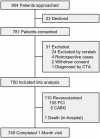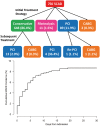Canadian spontaneous coronary artery dissection cohort study: in-hospital and 30-day outcomes
- PMID: 30698711
- PMCID: PMC6462308
- DOI: 10.1093/eurheartj/ehz007
Canadian spontaneous coronary artery dissection cohort study: in-hospital and 30-day outcomes
Abstract
Aims: Spontaneous coronary artery dissection (SCAD) was underdiagnosed and poorly understood for decades. It is increasingly recognized as an important cause of myocardial infarction (MI) in women. We aimed to assess the natural history of SCAD, which has not been adequately explored.
Methods and results: We performed a multicentre, prospective, observational study of patients with non-atherosclerotic SCAD presenting acutely from 22 centres in North America. Institutional ethics approval and patient consents were obtained. We recorded baseline demographics, in-hospital characteristics, precipitating/predisposing conditions, angiographic features (assessed by core laboratory), in-hospital major adverse events (MAE), and 30-day major adverse cardiovascular events (MACE). We prospectively enrolled 750 SCAD patients from June 2014 to June 2018. Mean age was 51.8 ± 10.2 years, 88.5% were women (55.0% postmenopausal), 87.7% were Caucasian, and 33.9% had no cardiac risk factors. Emotional stress was reported in 50.3%, and physical stress in 28.9% (9.8% lifting >50 pounds). Predisposing conditions included fibromuscular dysplasia 31.1% (45.2% had no/incomplete screening), systemic inflammatory diseases 4.7%, peripartum 4.5%, and connective tissue disorders 3.6%. Most were treated conservatively (84.3%), but 14.1% underwent percutaneous coronary intervention and 0.7% coronary artery bypass surgery. In-hospital composite MAE was 8.8%; peripartum SCAD patients had higher in-hospital MAE (20.6% vs. 8.2%, P = 0.023). Overall 30-day MACE was 8.8%. Peripartum SCAD and connective tissue disease were independent predictors of 30-day MACE.
Conclusion: Spontaneous coronary artery dissection predominantly affects women and presents with MI. Despite majority of patients being treated conservatively, survival was good. However, significant cardiovascular complications occurred within 30 days. Long-term follow-up and further investigations on management are warranted.
Keywords: Fibromuscular dysplasia (FMD); Myocardial infarction (MI); Percutaneous coronary intervention (PCI); Peripartum; Spontaneous coronary artery dissection (SCAD); Women.
Published on behalf of the European Society of Cardiology. All rights reserved. © The Author(s) 2019. For permissions, please email: journals.permissions@oup.com.
Figures






Comment in
-
Spontaneous coronary artery dissection: no longer a rare disease.Eur Heart J. 2019 Apr 14;40(15):1198-1201. doi: 10.1093/eurheartj/ehz048. Eur Heart J. 2019. PMID: 30844061 No abstract available.
References
-
- Saw J, Mancini GB, Humphries KH.. Contemporary review on spontaneous coronary artery dissection. J Am Coll Cardiol 2016;68:297–312. - PubMed
-
- Hayes SN, Kim ESH, Saw J, Adlam D, Arslanian-Engoren C, Economy KE, Ganesh SK, Gulati R, Lindsay ME, Mieres JH, Naderi S, Shah S, Thaler DE, Tweet MS, Wood MJ; American Heart Association Council on Peripheral Vascular Disease; Council on Clinical Cardiology; Council on Cardiovascular and Stroke Nursing; Council on Genomic and Precision Medicine; and Stroke Council. Spontaneous coronary artery dissection: current state of the science: a scientific statement from the American Heart Association. Circulation 2018;137:e523–e557. - PMC - PubMed
-
- Mahmoud AN, Taduru SS, Mentias A, Mahtta D, Barakat AF, Saad M, Elgendy AY, Mojadidi MK, Omer M, Abuzaid A, Agarwal N, Elgendy IY, Anderson RD, Saw J.. Trends of incidence, clinical presentation and in-hospital mortality among women with acute myocardial infarction with or without spontaneous coronary artery dissection: a population-based analysis. JACC Cardiovasc Interv 2018;11:80–90. - PubMed
-
- Saw J, Aymong E, Mancini J, Sedlak T, Starovoytov A, Ricci D.. Non-atherosclerotic coronary artery disease in young women. Can J Cardiol 2014;30:814–819. - PubMed
-
- Saw J, Mancini GB, Humphries K, Fung A, Boone R, Starovoytov A, Aymong E.. Angiographic appearance of spontaneous coronary artery dissection with intramural hematoma proven on intracoronary imaging. Catheter Cardiovasc Interv 2016;87:E54–E61. - PubMed
Publication types
MeSH terms
Supplementary concepts
Grants and funding
LinkOut - more resources
Full Text Sources
Medical
Miscellaneous

